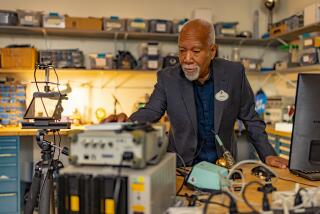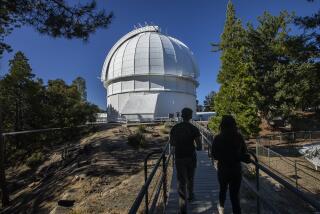Big-Bang Discovery Makes a Star Out of Astrophysicist : Cosmology: ‘It is the discovery of the century, if not of all time,’ says Stephen Hawking of Cambridge University.
- Share via
BERKELEY — Last year, astrophysicist George Smoot of the Lawrence Berkeley Laboratory got a very important message.
From the beginning of time.
Three weeks ago, he revealed that message, and the world, many people believe, changed forever.
Smoot and his colleagues reported that they had detected microwave signals from the oldest and largest structures in the universe, faint relics of the Big Bang, the seminal explosion that created the universe and everything in it 15 billion years ago.
These huge ripples in the fabric of space and time, hitherto indistinguishable from their surroundings, eventually evolved into the galaxies, stars, planets, comets, asteroids and all the other matter and debris that make up our universe.
Their discovery answers a riddle that has plagued cosmologists and physicists alike--how did the apparently featureless universe that existed shortly after the Big Bang evolve into the highly structured universe we now know? The answer is that these infinitesimal variations in the temperature and density of the primordial universe created different levels of gravity that, acting over billions of years, forced the wispy primeval gas to coalesce into solid bodies.
The finding, made with instruments aboard the Cosmic Background Explorer (COBE) satellite, has been widely hailed. “It is the discovery of the century, if not of all time,” cosmologist Stephen Hawking of Cambridge University, who ranks with Albert Einstein as one of the preeminent theorists of the century, said in a statement.
The discovery provides strong evidence in support not only of the Big Bang theory, Hawking said, but also of the idea that much of the universe--perhaps as much as 90%--is composed of so-called cold, dark matter. That cold, dark matter, according to cosmologists, will eventually slow and stop the expansion of the universe, and then will cause it to come crashing back together in a cataclysmic collapse, perhaps to start the whole process over again.
“They have found the Holy Grail of cosmology,” said physicist Michael Turner of the University of Chicago. “If it is indeed correct, this certainly would have to be considered for a Nobel Prize.”
That is heady praise for the 47-year-old Smoot, a brash experimentalist who has literally gone to the ends of the Earth in his search for evidence of the Big Bang. He has constructed microwave telescopes in the mountains of California, sent them aloft in balloons, carried them to the South Pole and finally launched one into orbit in an effort to find the elusive message.
And it is praise accompanied by a celebrity status that Smoot never dreamed of achieving. He has appeared on “Nightline” and on the “Today” show. Journalists from around the world have been calling his laboratory and demanding interviews. Several publishing companies want him to write a book.
Theorists have come to the remarkable conclusion that all of the matter in the universe--and all of the space as well--was initially contained in an infinitely dense ball smaller than the period at the end of a sentence. That may be difficult to comprehend, but cosmologists, like the queen in “Through the Looking-Glass,” “have to believe six impossible things before breakfast,” LBL astrophysicist Rich Muller said.
For its first 300,000 years, the universe was a fog of isolated electrons, protons and other elementary particles so dense that light could not penetrate it. But as the universe grew and cooled, electrons and protons combined into atoms of matter and the universe became transparent. It is this stage of the universe that Smoot is observing, perhaps 600,000 years after the Big Bang. Because the gas is so cold, 2.7 degrees above absolute zero (minus 455 degrees Fahrenheit), it emits energy in the form of microwave radiation.
This so-called cosmic microwave background was first detected in 1964 by physicists Arno Penzias and Robert Wilson of Bell Telephone Laboratories, a demonstration of the validity of the Big Bang theory for which they won the 1978 Nobel Prize for physics. But their telescope was not sensitive enough to reveal the small variations in temperature and density that theoreticians argued must have been present for the universe to evolve into its present highly structured state.
Smoot, a graduate of the Massachusetts Institute of Technology, came to the search in 1974. He brought with him, colleagues say, an intense appetite for work. He makes highly meticulous “action lists” describing each team member’s projects and goals for the forthcoming week. He is usually juggling three or four different projects, they note, but always remembers the intimate details of each. As he speaks, the words come faster and faster and his voice drops to near inaudibility.
Sitting in his cramped and cluttered office in an old building at LBL, with light classical music playing on a small radio, Smoot recently discussed his search and its aftermath. He was “initially very surprised” by the response to his announcement, he said.
“I knew it would be on the front pages of some newspapers, but I thought it would take two to three years before it got into the public consciousness. . . . It wasn’t until we started telling other people about the research that I began to really feel the excitement of what we had done, and something of the bigger meaning.”
He began the project, he said, as the result of advice from the late Luis Alvarez, a Nobel Prize-winning geologist who counseled him to find an important project that might require a lifetime of research, such as the search for the heavy neutrino, studies of variations in the Hubble constant (that measures the speed at which other galaxies are receding from our own) or the search for relics of the Big Bang.
“It was clear you weren’t going to find any of them right away,” he said.
He chose the Big-Bang project and, surprisingly, got some results quickly. Fifteen years ago, he reported that a microwave telescope flown aboard a converted U-2 spy plane had found that radiation from one half of the universe was slightly warmer than radiation from the other half.
He concluded that this apparent difference in temperature was a result of the Doppler effect--the same principle that causes a train’s whistle to change frequency as it passes. His measurements indicated that our Milky Way galaxy is traveling through the universe at a speed of about 1 million m.p.h. in the direction of the constellation Leo. It was the first measurement of the galaxy’s absolute speed--a measurement that many scientists did not even believe possible.
In their continuing search for evidence of the Big Bang, Smoot’s team built bigger and better microwave telescopes. Some were used atop White Mountain, near Bishop, Calif. Others were flown in NASA’s U-2 and in balloons. One balloon flight was memorable because the telescope disappeared for two years when the balloon failed to drop it in response to a radio command.
The telescope was eventually found in the top of a tree in a Brazilian wildlife preserve. Rescuers chopped the tree down and then, deciding the instrument was too heavy to carry, “disassembled” it with their machetes. The telescope was a loss, but the moldy data was recovered.
Smoot and his team have twice taken one telescope to the South Pole, where the high altitude and clear, dry air enhance viewing. The 30-foot-wide antenna for the telescope was assembled by hand more than a mile from the polar station, a project that required team members to work barehanded in the minus-40-degree temperatures of the Antarctic summer.
Typical of Smoot, he continued to direct the team’s other projects by radio from the Pole. “I just made a few suggestions,” he said modestly.
These measurements did not reveal any variations in the microwave background and Smoot, frankly, did not expect them to. But they did allow the team to build a better model of the universe, which helped them understand the satellite data. “And some measurements are just to keep the group sharp,” he said.
Success came with the COBE observatory, which was launched from Vandenberg Air Force Base in November, 1989. The observatory carries a telescope designed by Smoot and others that is a factor of 2 more sensitive than his earthbound instruments.
During its first year, the telescope aboard COBE made more than 420 million individual measurements that were processed by Smoot’s team at LBL and at NASA’s Goddard Space Flight Center in Greenbelt, Md., where he maintains a house and spends nearly half of each year. Last September, they began to see traces of the large structures in the data, and Smoot began to push his colleagues hard to eliminate all possible sources of error.
To keep the team’s attention focused on the data analysis, Smoot offered a free vacation anywhere in the world--using his copious frequent flier miles--to anyone who could find a mistake in the data. Many tried, especially UCLA astronomer Ned Wright, but no one was able to collect.
Smoot finally became convinced of his success in February after graduate student Charlie Lineweaver performed another computer simulation of the data, using a different set of assumptions, and obtained the same results. Lineweaver penciled “Eureka?” across the printout and slipped it under Smoot’s office door at 2 a.m. “He loves messages slipped under the door,” Lineweaver said.
Meanwhile, Smoot kept the results a secret until he could formally present them. Team member Giovanni de Vici recalled the frustration he felt because he couldn’t even confide their results to his two office mates, who belonged to different research groups. LBL information officer Jefferey Kahn, who was privy to the secret, was forbidden to tell his boss about the finding. The unmarried Smoot did not even tell his parents, who learned about the discovery on television.
When the group presented their results recently to an all-day meeting of the COBE science team, Smoot appeared in a rented tuxedo “to show my guys it was really a milestone.”
Since their public announcement three weeks ago at a Washington meeting of the American Physical Society, Smoot has been unable to get much work done because of the demands of celebrity. When he returned to Berkeley, his computer had more than 3,000 messages on it--full capacity--and he was advising close friends to send E-mail to a more restricted mailbox that few know of. His desk is piled high with mail and requests.
He is flattered, but somewhat bewildered, by the attention and the talk of a Nobel Prize, but he is trying to avoid such speculation. “If you think about it, you just start worrying,” he said. “Right now, I’d just like to get back to work.”
The team has another year and a half of COBE data to process, data that should confirm the validity of their announcement. And Smoot is planning more balloon flights with a newer, more sensitive telescope that should be capable of seeing the structures. He has to keep one step ahead because, after all, “There’ll be a lot more people working on this now. It’s really a hot topic.”






